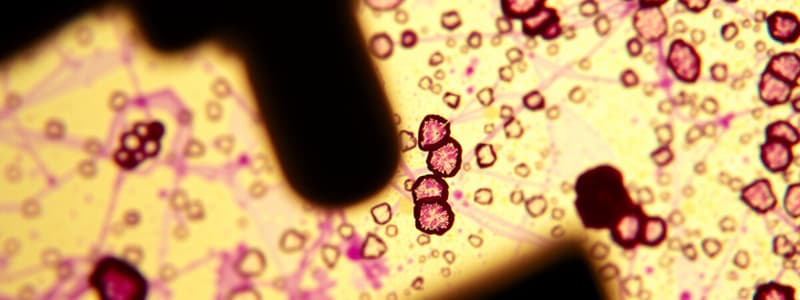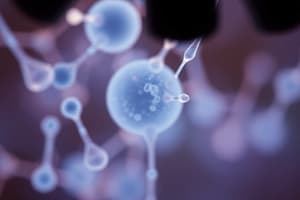Podcast
Questions and Answers
What is the magnification equation?
What is the magnification equation?
Magnification = image size / actual object size
How many micrometers (um) are in 1 millimeter (mm)?
How many micrometers (um) are in 1 millimeter (mm)?
1000 um
How many nanometers (nm) are in 1 micrometer (um)?
How many nanometers (nm) are in 1 micrometer (um)?
1000 nm
Why can we see the nucleus and cell wall with a light microscope but not the mitochondria?
Why can we see the nucleus and cell wall with a light microscope but not the mitochondria?
How can we see smaller parts of cells?
How can we see smaller parts of cells?
What is osmosis?
What is osmosis?
What is a solute?
What is a solute?
What are the results of investigating osmosis?
What are the results of investigating osmosis?
What are the control variables in investigating osmosis?
What are the control variables in investigating osmosis?
Why should you remove excess water with paper towels before weighing in osmosis experiments?
Why should you remove excess water with paper towels before weighing in osmosis experiments?
How do you test for starch?
How do you test for starch?
How do you test for protein?
How do you test for protein?
How do you test for reducing sugar?
How do you test for reducing sugar?
How do you test for lipids?
How do you test for lipids?
Why do you need a water bath when investigating amylase enzyme?
Why do you need a water bath when investigating amylase enzyme?
Why might the exact optimum pH not be determined when testing amylase enzyme across various pH levels?
Why might the exact optimum pH not be determined when testing amylase enzyme across various pH levels?
What are sources of error and weaknesses when investigating amylase enzyme?
What are sources of error and weaknesses when investigating amylase enzyme?
What is the effect of light on photosynthesis?
What is the effect of light on photosynthesis?
Why might results of photosynthesis experiments be inaccurate?
Why might results of photosynthesis experiments be inaccurate?
Why should you leave the plant for a few minutes before starting to count bubbles in photosynthesis experiments?
Why should you leave the plant for a few minutes before starting to count bubbles in photosynthesis experiments?
How can you avoid heat from the lamp being a source of error in photosynthesis experiments?
How can you avoid heat from the lamp being a source of error in photosynthesis experiments?
What are the other limiting factors for photosynthesis apart from light?
What are the other limiting factors for photosynthesis apart from light?
Why do you have to repeat the reaction time investigation?
Why do you have to repeat the reaction time investigation?
What apparatus should you use to measure population size?
What apparatus should you use to measure population size?
What is a cell membrane important for?
What is a cell membrane important for?
What is a cell wall important for?
What is a cell wall important for?
What is the vacuole important for?
What is the vacuole important for?
What happens in the cytoplasm?
What happens in the cytoplasm?
What are ribosomes responsible for?
What are ribosomes responsible for?
What is produced at the mitochondria?
What is produced at the mitochondria?
Name all the components in an animal cell.
Name all the components in an animal cell.
What is present in a plant cell but not in an animal cell?
What is present in a plant cell but not in an animal cell?
Name all parts of a bacterial cell.
Name all parts of a bacterial cell.
How does a cell specialize?
How does a cell specialize?
Flashcards
Magnification Equation
Magnification Equation
Magnification = image size / actual object size
Micrometer to Millimeter
Micrometer to Millimeter
1 mm = 1000 μm
Micrometer to Nanometer
Micrometer to Nanometer
1 μm = 1000 nm
Light Microscope Limitation
Light Microscope Limitation
Signup and view all the flashcards
Osmosis
Osmosis
Signup and view all the flashcards
Solute
Solute
Signup and view all the flashcards
Osmosis Experiment Potato
Osmosis Experiment Potato
Signup and view all the flashcards
Control Variable (Osmosis)
Control Variable (Osmosis)
Signup and view all the flashcards
Starch Test
Starch Test
Signup and view all the flashcards
Protein Test
Protein Test
Signup and view all the flashcards
Reducing Sugar Test
Reducing Sugar Test
Signup and view all the flashcards
Lipid Test
Lipid Test
Signup and view all the flashcards
Enzyme Investigation Temperature
Enzyme Investigation Temperature
Signup and view all the flashcards
Enzyme Investigation pH
Enzyme Investigation pH
Signup and view all the flashcards
Enzyme Experiment Errors
Enzyme Experiment Errors
Signup and view all the flashcards
Photosynthesis Rate & Light
Photosynthesis Rate & Light
Signup and view all the flashcards
Photosynthesis Rate & Bubbles
Photosynthesis Rate & Bubbles
Signup and view all the flashcards
Photosynthesis Acclimation
Photosynthesis Acclimation
Signup and view all the flashcards
Photosynthesis vs. Heat
Photosynthesis vs. Heat
Signup and view all the flashcards
Photosynthesis Limiting Factors
Photosynthesis Limiting Factors
Signup and view all the flashcards
Population Sampling
Population Sampling
Signup and view all the flashcards
Cell Membrane Function
Cell Membrane Function
Signup and view all the flashcards
Cell Wall Function
Cell Wall Function
Signup and view all the flashcards
Vacuole Function
Vacuole Function
Signup and view all the flashcards
Ribosomes Function
Ribosomes Function
Signup and view all the flashcards
Mitochondria Function
Mitochondria Function
Signup and view all the flashcards
Animal Cell Structure
Animal Cell Structure
Signup and view all the flashcards
Plant Cell Structure
Plant Cell Structure
Signup and view all the flashcards
Bacterial Cell Structure
Bacterial Cell Structure
Signup and view all the flashcards
Cell Specialization
Cell Specialization
Signup and view all the flashcards
Study Notes
Microscopy
- Magnification equation: Magnification = image size / actual object size.
- 1 mm equals 1000 micrometers (um).
- 1 um equals 1000 nanometers (nm).
- Light microscopes can visualize nuclei and cell walls, but not mitochondria due to their small size and lack of staining.
- Electron microscopes provide higher resolution and magnification for viewing smaller cellular components.
Osmosis
- Osmosis defined as the movement of water from high to low concentration areas.
- Solute: A substance that dissolves in water.
- In osmosis investigations: high sugar concentrations lead to water leaving potato cells, resulting in smaller potatoes; low concentrations cause potato cells to swell.
- Control variable in osmosis experiments includes the amount of sugar solution used.
- Excess water on potato samples before weighing must be removed to accurately assess changes in water content.
Testing for Biological Molecules
- Starch test: Add iodine; turns blue-black if starch is present.
- Protein test: Add biuret reagent; turns purple if protein is present.
- Reducing sugar test: Add Benedict's solution and heat for 2 minutes; turns red if reducing sugars are present.
- Lipid test: Add ethanol followed by water; turns cloudy if lipids are present.
Enzyme Investigations
- A water bath is used to maintain a constant temperature during amylase enzyme investigations, as temperature affects reaction rates.
- Testing different pH levels may not yield the exact optimum pH because the actual optimum could lie between tested values.
- Common errors in enzyme experiments arise from inaccurate measurements and timing.
Photosynthesis
- Closer light sources result in a faster bubble production rate, indicating a higher rate of photosynthesis.
- Inaccurate results in counting bubbles may occur due to size variability; all bubbles count as one, regardless of size.
- Allowing time for plants to acclimate to light and temperature ensures accurate photosynthesis rates.
- To reduce heat interference from light sources, a glass screen can be used to allow light but block heat.
- Photosynthesis is also limited by temperature and carbon dioxide levels, which can prevent rates from increasing despite maximal light availability.
Population Sampling
- When measuring population size, a quadrat is the recommended apparatus for sampling.
Cell Structure and Function
- Cell membranes regulate the passage of substances in and out of cells.
- Cell walls provide structural support in both plant cells and prokaryotes.
- The vacuole in plant cells stores nutrients and maintains turgor pressure.
- Ribosomes are responsible for synthesizing proteins.
- Mitochondria are the sites of energy production.
- Animal cells contain membranes, mitochondria, ribosomes, cytoplasm, and nuclei.
- Plant cells have additional structures: cell walls, vacuoles, and chloroplasts.
- Bacterial cells include membranes, cytoplasm, chromosomal DNA, flagella, ribosomes, and cell walls.
Cell Specialization
- Cells initially possess similar structures but differentiate based on function, adapting features suitable for their specific roles.
Studying That Suits You
Use AI to generate personalized quizzes and flashcards to suit your learning preferences.
Description
This quiz consists of flashcards covering key concepts from the AQA GCSE Biology Paper 1 syllabus. It addresses important topics such as magnification equations, the measurement units used in light microscopy, and the visibility of cellular structures. Test your knowledge and prepare for your exam effectively with these concise definitions.




